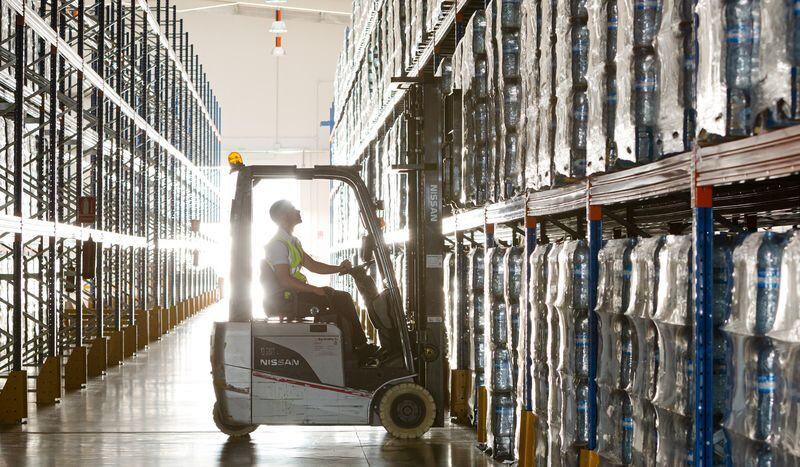A Recession Business Strategy for Manufacturing Companies
You’ve likely heard the forecasts of an impending recession. Some people might even have warned you of the possibility of a depression. We’re in no place to make a judgment on whether or not these predictions will come true, but we do know what you can do to prepare, just in case.
During downturns, users of Veryable’s on-demand labor marketplace can instantly scale down their labor capacity to keep costs in control and confidently scale up operations in the uncertainty that follows. We’ve seen companies do this time and time again as external circumstances attacked their businesses.
In this article, you’ll learn what a recession typically looks like for a manufacturing business, what it could look like for your business if you build flexible labor capacity, and how to prepare for any possibility now.
What does a recession look like for a manufacturing business?
During a down cycle or recession, there is a typical series of events that plays out in manufacturing businesses. You’ve likely felt the pain of this before in your own operations as demand slows down and you’re facing some tough decisions.
With the traditional approach of staffing, rigidity and delayed response to demand create and amplify problems during a down cycle.
The graph below shows the typical timeline from the beginning of a recession.

- Labor capacity fluctuates with natural attrition and hiring.
- Macroeconomic factors (i.e. recession or other external event) reduce demand
- The business starts layoffs when attrition isn’t enough to match lower demand
- Demand increases as the recession fades. The business uses overtime and tries to hire people to keep up
- The business makes more hires, although they are hesitant because they aren’t sure if the demand will persist
Note that anywhere in the graph above where there is space between the demand line and capacity line that there is inefficiency. And there is a lag between demand changes and capacity changes. This is not unique to a recession; rather, this is unique to the traditional staffing model.
What Can You Do to Prepare Your Manufacturing Business for a Recession?
While it is tempting to use the recession to absolve yourself of responsibility, there are steps you can take to alleviate some of the pain that is caused by such uncontrollable events. By building flexible labor capacity, you will be able to easily scale down when demand drops, thereby eliminating or drastically reducing the amount of layoffs and subsequent hiring sprees you would otherwise have to endure.
Nobody wants to be in the news for mass layoffs during a recession. The good news is that some of this can be avoided. While some drops in demand are going to happen during the macroeconomic business cycle, big recession layoffs are often due to excessive hiring resulting from prior growth forecasts based on temporary demand increases.
If companies grew based on actual demand rather than forecasts, this wouldn’t be as big of a problem. You wouldn’t see 50% of staff being laid off, as is so common.
Flexible labor capacity alleviates this problem. If you know that you can scale from day to day without making permanent hires, you don’t end up with more people than you need when demand naturally fluctuates.
Some layoffs are likely going to be necessary during a down cycle. This is an ugly truth that businesses and workers have to face.
There is a way to fix this though: make the barrier for moving between work opportunities lower so that when one business doesn’t have demand, the workers can flow to where the opportunities are. The businesses win and the workers win.
That is why flexible labor capacity is not just for when your company is on an upward trajectory. This is short-sighted thinking. You need a way to grow sustainably and accurately, so that you don’t hire and then fire a big batch of workers based on a temporary demand increase.
Using On-Demand Labor to Survive a Recession
With on-demand labor for flexible capacity, your business has more agility in responding to demand changes.
Here is the typical order of events during a down cycle for businesses when they have built flexible capacity using on-demand labor:
- Demand increases
- Operations strategists plan their production on a short time horizon
- Businesses use flexible capacity to meet increased demand in real time
- Businesses scale back down by reducing usage of flexible capacity in real time
- Businesses periodically analyze their headcount to determine if full-time hires are necessary to meet the consistent baseline demand
- Businesses hire only when truly necessary
Notice the lack of hiring and firing. As you can see in the graph below, on-demand labor allows you to instantly adjust capacity to respond to external circumstances, such as the winter storm that impacted Texas in early 2022.

The graph above shows how a company built a flexible labor capacity throughout the year in anticipation of the holiday rush. Then they scaled back down until they needed the extra labor again to meet increased demand they acquired when they bought their competitor.
When a winter storm hit the company and slowed business, they scaled down their labor capacity dramatically for one week. Then as the ice thawed, they instantly went back to their previous levels of workers and continued to meet rising demand.
How to Build Agility with On-Demand Labor
There are things you can do before, during, and after a down cycle with on-demand labor to ensure that your business is successful.
To learn practical steps you can take, read our blog article on how to create down cycle agility with on-demand labor.
Previous Posts
Trump 2.0 Week 13 Recap: Discussing Ongoing Negotiations With Key Trade Partners, A Potential Deal With China On The Horizon, and More
The Future of Manufacturing and Logistics
Create a free business profile today to explore our platform.






